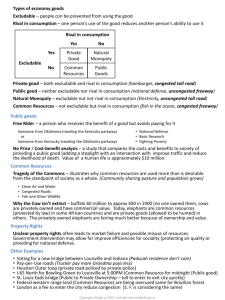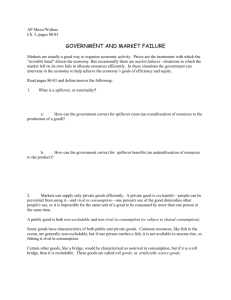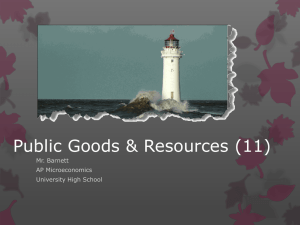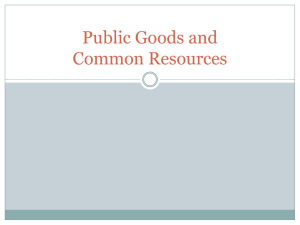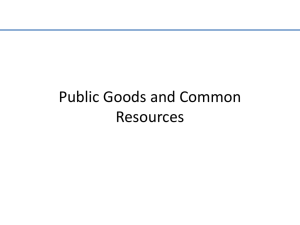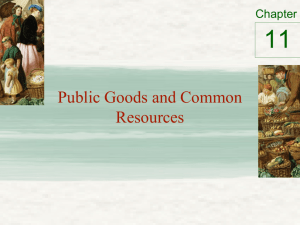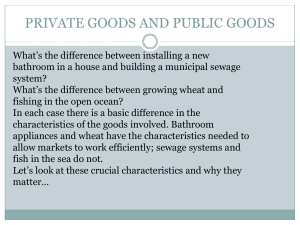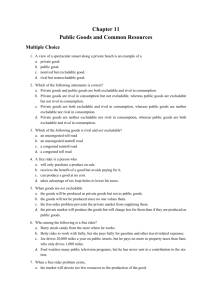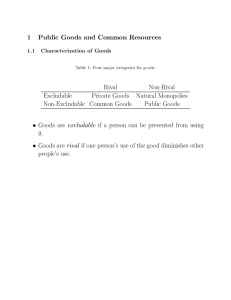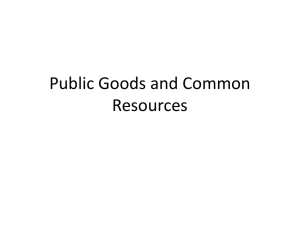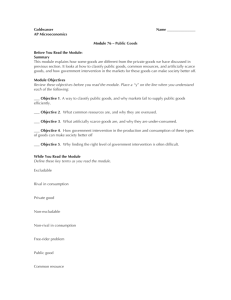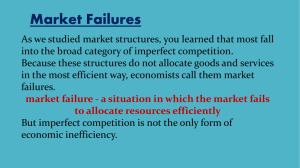Green Economics Homework 2 Essay questions. Based on Chapter
advertisement
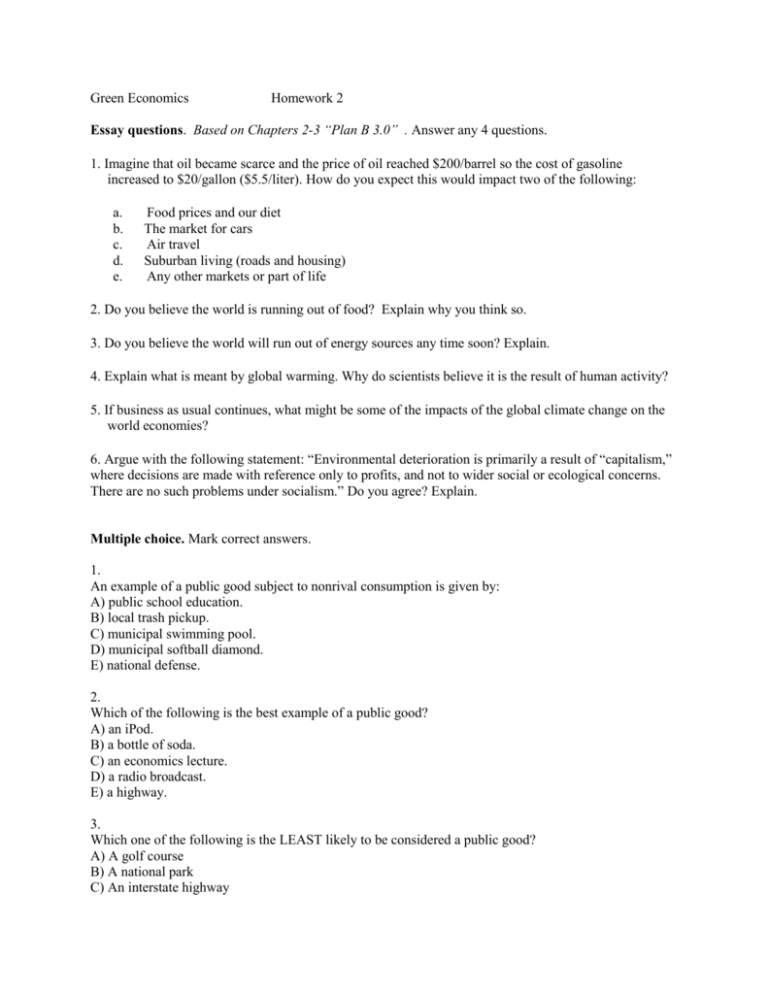
Green Economics Homework 2 Essay questions. Based on Chapters 2-3 “Plan B 3.0” . Answer any 4 questions. 1. Imagine that oil became scarce and the price of oil reached $200/barrel so the cost of gasoline increased to $20/gallon ($5.5/liter). How do you expect this would impact two of the following: a. b. c. d. e. Food prices and our diet The market for cars Air travel Suburban living (roads and housing) Any other markets or part of life 2. Do you believe the world is running out of food? Explain why you think so. 3. Do you believe the world will run out of energy sources any time soon? Explain. 4. Explain what is meant by global warming. Why do scientists believe it is the result of human activity? 5. If business as usual continues, what might be some of the impacts of the global climate change on the world economies? 6. Argue with the following statement: “Environmental deterioration is primarily a result of “capitalism,” where decisions are made with reference only to profits, and not to wider social or ecological concerns. There are no such problems under socialism.” Do you agree? Explain. Multiple choice. Mark correct answers. 1. An example of a public good subject to nonrival consumption is given by: A) public school education. B) local trash pickup. C) municipal swimming pool. D) municipal softball diamond. E) national defense. 2. Which of the following is the best example of a public good? A) an iPod. B) a bottle of soda. C) an economics lecture. D) a radio broadcast. E) a highway. 3. Which one of the following is the LEAST likely to be considered a public good? A) A golf course B) A national park C) An interstate highway D) Wildlife E) A river 4. The free-rider problem is that: A) free education is not free for the tax payers. B) free public transportation is overcrowded. C) government supplies goods at no charge to people who could otherwise afford them. D) people will not voluntarily pay for a good when they can obtain the benefits of the good without paying E) public goods often create external costs. 5. The socially optimal provision of a public good can be found by A) Allowing open access to the good B) Eliminating access to the good C) Horizontally adding the demand curves for the good D) Vertically adding the demand curves for the good E) Privatizing the good 6. Suppose a householder decides not to participate in a neighborhood cleanup, but his/her property values increase as a result of a cleaner neighborhood. This is an example of A) Public choice B) Free market environmentalism C) Free rider effect D) Transactions costs E) Opportunity costs 7. Neither public goods nor common resources are A) excludable, but only public goods are not rival in consumption. B) excludable, but only common resources are not rival in consumption. C) rival in consumption, but only public goods are not excludable. D) rival in consumption, but only common resources are not excludable. 8. Private firms will not provide such goods as lighthouses, flood-control projects, national defense, space exploration and city road maintenance because: A) such projects generate harmful spillover effects B) marginal benefits invariably fall short of marginal costs in such projects C) these are major sources of revenue for government D) there is no way of denying benefits to those who are unwilling to pay E) these projects do not benefit the society 9. Which one of the following goods can be considered a global commons? A) A diamond mine B) An ocean C) A herd of deer D) A lake E) A National Park 10. Why has the value of ivory threatened the extinction of the elephant, whereas the value of beef has enhanced the survival of the cow? A) Elephants are larger than cows, requiring more economic resources. B) Cows are a common resource, whereas elephants are owned by governments. C) Elephants live in Africa, where economic resources are scarce. D) Elephants are a common resource, whereas cows are privately owned. 11. The Great Lakes are A) natural monopolies. B) public goods. C) private goods. D) common resources. 12. An ice cream cone is A) excludable and rival in consumption. B) excludable and not rival in consumption. C) not excludable and rival in consumption. D) not excludable and not rival in consumption. E) good a good breakfast 13. A view of a spectacular sunset along a private beach is an example of a A) nonrival but excludable good. B) rival but nonexcludable good. C) common resource. D) private good. E) public good. 14. An overcrowded beach is an example of A) Tragedy of the Commons. B) Positive externality. C) An environmentally irrational allocation of resources. D) An economically unfair allocation of resources. 15. The “tragedy of the commons” is most likely to occur with which one of the following goods? A) A city park B) A public highway C) Natural gas and oil D) National defense E) Fish in the ocean 16. Which of the following quotations illustrates the Tragedy of the Commons? A) A bird in the hand is worth two in the bush. B) You can't always get what you want. C) Anyone who is not a socialist before he is 30 has no heart; anyone who is still a socialist after he is 30 has no head. D) What is common to many is taken least care of, for all men have greater regard for what is their own than for what they possess in common with others. E) The only difference between the rich and other people is that the rich have more money. 17. If a community is assigned property rights over air quality and the environment, a steel mill in the community that generates air pollution: A) will sue damages and for the right to produce steel. B) will cease to pollute. C) can contract to pay the community to allow some level of air pollution. D) must shut down. E) will outsource production to a "pollution heaven" country, such as China. 18. The Ogallala aquifer is a large underground pool of fresh water under several western states in the United States. Any farmer with land above the aquifer can at present pump water out of it. Which of the following statements about the aquifer is correct? A) The aquifer is a artificially scarce good which should be left as it is. B) The aquifer is a private good which must be privately owned to be used efficiently. C) The aquifer is a public good which must be publicly owned to be used efficiently. D) The aquifer is a common property resource which will be overused if no one owns it. 19. If 10,000 people are willing to spend a maximum of $20 each to preserve one acre of rainforest, how many acres of rainforest could be preserved, at $40 per acre without exceeding people’s willingness to pay? A) Zero acres B) 1,000 acres C) 5,000 acres D) 10,000 acres E) why do you keep asking the rainforest question?
